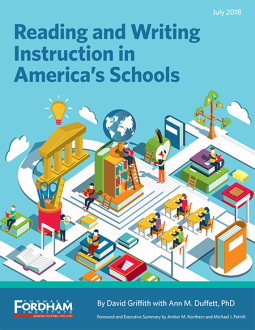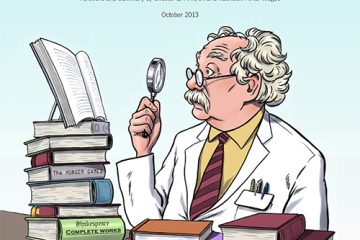Since 2010, when most states adopted the Common Core State Standards (CCSS), the Thomas B. Fordham Institute has been committed to monitoring their implementation. One of our initial reports, written in 2013 by lead author Tim Shanahan, surveyed middle and high school English language arts (ELA) teachers and found broad support for the CCSS-ELA, yet highlighted several red flags.
Five years later, the CCSS (or close facsimiles) are still in place in most states. And given that high expectations only matter when reflected in classroom practice, we owe it to teachers to continue supporting their efforts to implement these more rigorous standards.
Accordingly, we’re back with another nationally representative survey of ELA teachers.
Reading and Writing Instruction in America’s Schools, authored by Fordham’s senior research and policy associate David Griffith and FDR Group’s Ann Duffett, suggests real progress in implementing state ELA standards, but also—like the baseline 2013 report—real cause for concern. For example, middle and high school teachers are asking more text-dependent questions and report that students’ ability to accurately cite evidence from the text has improved—both of which are in line with the CCSS-ELA. Yet they have also become more likely to assign texts based on students’ current reading levels—as opposed to their grade levels—contrary to the intent of the standards. There are troubling signs on other fronts, too: fewer classic works of literature that teachers are assigning; a predilection for creative over evidence-based writing; and students’ continued lack of content knowledge.
Based on the results, we draw four conclusions:
First, if we want teachers to assign texts based on students’ grade levels—rather than their reading levels—we need to do more to help them bridge the gap between the two. Increasing the complexity of the texts that all students are exposed to is a hallmark of the CCSS-ELA, yet the survey results suggest that there has been serious backsliding in this area since our 2013 report. In our view, the most likely explanation is that teachers lack the supports they need to carry out this portion of their mission.
Second, teachers should take another look at their ELA curriculum to make sure they aren’t overlooking classic works of literature. Although it’s encouraging that ELA teachers are assigning more informational texts and literary nonfiction, as the CCSS expect, it’s concerning that they seem to be doing so at the expense of “classic works of literature.”
Third, writing instruction needs serious attention. By the time students graduate high school, they should be able to construct a coherent argument. Yet the results suggest that teachers are still prioritizing creative expression over evidence-based writing.
Finally, teachers should tackle the content-knowledge deficit. In particular, they should take the lead in adopting content-rich curricula and organizing their lessons around well-constructed “text sets” that help students build on their prior knowledge and learn new words more quickly.
In addition to the survey results, the report also features seven “Literacy Lifelines” that contain practical advice for teachers who are struggling with the challenges outlined above. May they not tire from the hard work of implementation!





